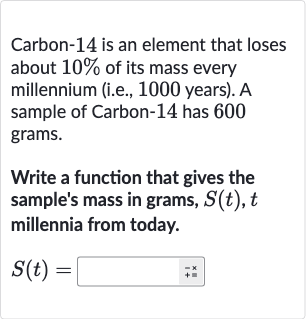Full solution
Q. Carbon is an element that loses about of its mass every millennium (i.e., years). A sample of Carbon has grams.Write a function that gives the sample's mass in grams, millennia from today.
- Exponential Decay Function: Step : To model the decay of Carbon, we use an exponential decay function. The general form of an exponential decay function is , where is the initial amount, is the decay rate per time period, and is the number of time periods. In this case, is grams, is or , and is the number of millennia.
- Substitute Values: Step : Substitute the given values into the exponential decay function. We get . This simplifies to , since .
- Final Mass Calculation: Step : The function now represents the mass of the Carbon sample in grams, millennia from today.
More problems from Interpret the exponential function word problem
QuestionGet tutor help
QuestionGet tutor help
QuestionGet tutor help
QuestionGet tutor help
QuestionGet tutor help
QuestionGet tutor help
QuestionGet tutor help
QuestionGet tutor help
QuestionGet tutor help

